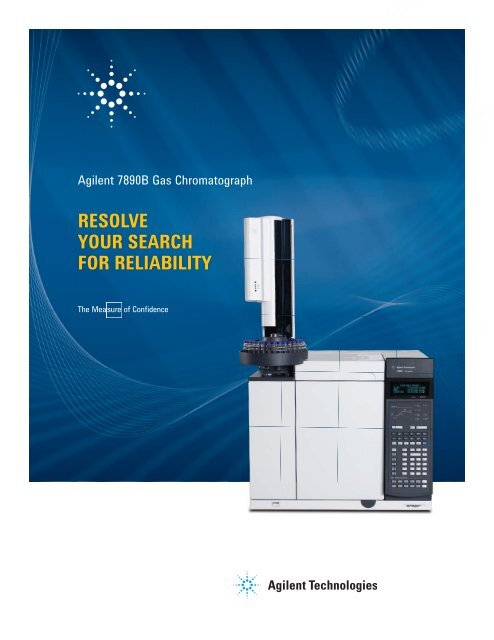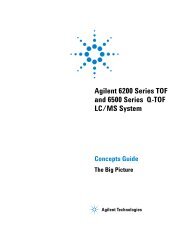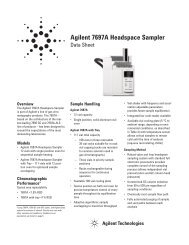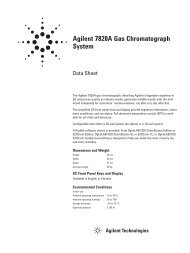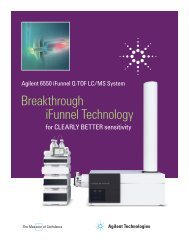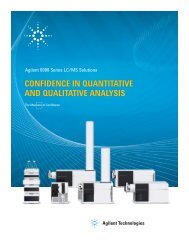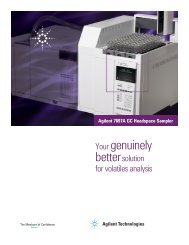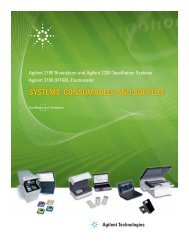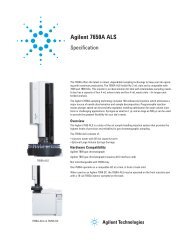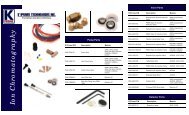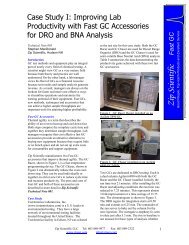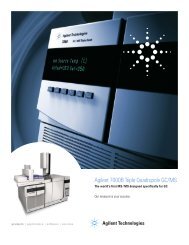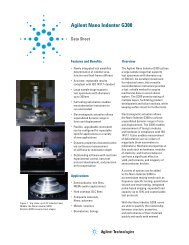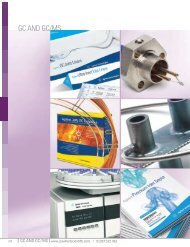7890B Brochure.indd - Agilent Technologies
7890B Brochure.indd - Agilent Technologies
7890B Brochure.indd - Agilent Technologies
You also want an ePaper? Increase the reach of your titles
YUMPU automatically turns print PDFs into web optimized ePapers that Google loves.
<strong>Agilent</strong> <strong>7890B</strong> Gas Chromatograph<br />
RESOLVE<br />
YOUR SEARCH<br />
FOR RELIABILITY
Resolve your search for the next evolution<br />
in gas chromatography<br />
The NEW <strong>Agilent</strong> <strong>7890B</strong> GC<br />
Building the world’s most trusted GC system is an ongoing process. With every step, we increase<br />
speed, improve functionality, and incorporate new analytical capabilities – all while never losing sight<br />
of the most important objective: results.<br />
Now, <strong>Agilent</strong> has achieved a new level of GC performance and GC/MSD system<br />
integration<br />
<strong>Agilent</strong>’s flagship <strong>7890B</strong> GC system has everything you need to boost productivity, protect our<br />
environment through better resource management, and generate data with confidence. In addition,<br />
its seamless communication with the <strong>Agilent</strong> 5977A Series GC/MSD provides faster vent times and<br />
system protections when using hydrogen carrier gas.<br />
The <strong>Agilent</strong> <strong>7890B</strong> GC adds<br />
integrated “smart” functionality<br />
and improved performance to the<br />
industry-leading GC platform.
Proven reliability meets improved performance<br />
<strong>Agilent</strong>’s 5th-generation electronic pneumatics control (EPC)<br />
and digital electronics are now complemented by improved<br />
detector specifications, making the <strong>7890B</strong> <strong>Agilent</strong>’s most<br />
dependable – and highest-performing GC – ever.<br />
Higher sample throughput<br />
Fast oven cool-down, new backflush capabilities, and<br />
advanced automation features help you get more done in less<br />
time, at the lowest possible cost per sample. All can easily be<br />
incorporated into your existing method.<br />
NEW integrated intelligence<br />
Early maintenance feedback lets you replace parts quickly, and<br />
address small problems before they lead to costly downtime.<br />
Built-in calculators and method translator are also integrated<br />
into the data system software to simplify method setup and<br />
system operation.<br />
What’s more, the improved GC MSD communication<br />
cuts venting time by up to 40%, and protects the system<br />
from damage by stopping the flow of carrier gas during<br />
shutdown events.<br />
Expanded chromatographic capabilities<br />
A flexible EPC design enables sophisticated analyses, while<br />
an optional 3rd detector (TCD or ECD) lets you run multiple<br />
analyses on a single GC.<br />
Leading-edge technologies<br />
increase analytical<br />
capabilities and<br />
reliability<br />
Faster, more intuitive software<br />
New <strong>Agilent</strong> OpenLAB CDS is 40 times faster. Tools<br />
and wizards have also been added to help you turn<br />
results into answers, faster. Page 10<br />
End-to-end protection for active compounds<br />
Ultra Inert liners, gold seals, columns, and improved<br />
inert flow path from injection to detection. Page 9<br />
Enhanced inlet and detector modules<br />
Numerous module enhancements let you<br />
customize your GC system in minutes to suit your<br />
changing application needs. Page 8<br />
New integrated system maintenance<br />
and Parts Finder tools<br />
Reduce downtime and operating costs with<br />
simplified maintenance and status monitoring.<br />
Find consumables and replacement parts faster<br />
with a 3D graphical tool. Page 12<br />
Enhanced Capillary Flow Technology (CFT)<br />
CFT modules enable leak-free, in-oven connections<br />
while improving throughput and reliability. An easy<br />
setup wizard gets you up and running quickly.<br />
Page 6<br />
Wide choice of system components<br />
Configure and automate your system to increase<br />
efficiency and productivity – and expand your<br />
analytical capabilities. Page 14, 21<br />
Eco-friendly operation<br />
Sleep mode reduces power and gas<br />
consumption during periods of inactivity,<br />
while Wake mode readies the system<br />
for high-throughput operation. You can<br />
also switch to lower-cost gases while in<br />
standby mode. Page 12<br />
Reduce dependency on helium<br />
Integrated calculators help you convert helium<br />
methods to more available – and less expensive –<br />
gases like hydrogen or nitrogen. Page 12<br />
To learn more about the <strong>Agilent</strong> <strong>7890B</strong> GC, visit www.agilent.com/chem/<strong>7890B</strong><br />
3
Advanced capabilities help you get the job done, faster<br />
<strong>Agilent</strong>’s <strong>7890B</strong> GC builds on a 45-year tradition of leadership and<br />
innovation, providing everything you need to take your lab to the next<br />
level of GC and GC/MS productivity, performance, and resource<br />
management.<br />
The heart of performance<br />
Precise pneumatics and oven<br />
temperature control, combined with<br />
<strong>Agilent</strong> J&W Ultra Inert GC columns,<br />
give you outstanding resolution and<br />
retention time repeatability – the basis<br />
for all chromatographic measurement.<br />
The heart of reliability<br />
No other manufacturer has <strong>Agilent</strong>’s<br />
depth of experience in electronic flow<br />
control. Our pneumatics manifold<br />
reduces the need for parts and seals,<br />
improving gas flow precision and<br />
stability. Integrated electronics and<br />
advanced mechanical design further<br />
enhance dependability and versatility.<br />
4
Precise Retention Time Locking<br />
(RTL) software<br />
RTL reproduces retention times from<br />
one <strong>Agilent</strong> GC system to another –<br />
regardless of inlet, detector, operator, or<br />
location. So you can confidently transfer<br />
methods worldwide.<br />
<strong>Agilent</strong>’s 5th generation EPC and<br />
digital electronics further improve RTL<br />
precision for low-pressure applications<br />
(to 0.001 psi actual).<br />
Response 6.624<br />
200000<br />
190000<br />
180000<br />
170000<br />
160000<br />
150000<br />
140000<br />
130000<br />
120000<br />
110000<br />
100000<br />
90000<br />
80000<br />
Time<br />
Column 1<br />
at 1.000 psi<br />
6.619<br />
6.624 (Target RT)<br />
6.641<br />
0.97 psi 0.967 psi 0.96 psi<br />
6.58 6.59 6.60 6.61 6.62 6.63 6.64 6.65 6.66 6.67 6.68 6.69<br />
5989-8366EN: Low Pressure Retention Time Locking with the 7890 GC<br />
Unsurpassed retention time<br />
reproducibility<br />
5th-generation electronic pneumatics<br />
control (EPC) makes it easy to set<br />
pressure and flow – and to keep these<br />
setpoints consistent from run to run for<br />
retention time repeatability.<br />
Run Peak 1* Peak 2*<br />
1 9.0839 min 11.8492 min<br />
2 9.0835 11.8492<br />
3 9.0841 11.8494<br />
4 9.0846 11.8496<br />
5 9.0851 11.8507<br />
6 9.0849 11.8502<br />
7 9.0845 11.8504<br />
8 9.0849 11.8500<br />
9 9.0847 11.8504<br />
10 9.0853 11.8502<br />
11 9.0852 11.8502<br />
12 9.0851 11.8508<br />
13 9.0847 11.8503<br />
14 9.0848 11.8507<br />
15 9.0853 11.8506<br />
Average 9.0847 min 11.8501 min<br />
Standard Deviation 0.000527 0.000535<br />
*Heart-cut from column 1.<br />
pA<br />
12<br />
10<br />
15 overlaid heart cut<br />
chromatograms on<br />
Peak 2 showing<br />
unsurpassed reproducibility<br />
8<br />
6<br />
4<br />
2<br />
11.78 11.8 11.82 11.84 11.86 11.88 11.9 11.92<br />
min<br />
Achieve unsurpassed retention time reproducibility in standard applications – even with multi-dimensional<br />
applications, such as the heart-cutting example shown here.<br />
To learn more about the <strong>Agilent</strong> <strong>7890B</strong> GC, visit www.agilent.com/chem/<strong>7890B</strong><br />
5
Add dimension to your chromatography<br />
with Capillary Flow Technology<br />
<strong>Agilent</strong>’s proprietary Capillary Flow Technology (CFT) solves<br />
a problem chromatographers have been wrestling with for decades:<br />
creating leak-free capillary connections that can withstand the<br />
temperature extremes of a modern GC oven.<br />
CFT devices are inert, with low mass and low dead volume to help you<br />
make secure connections and precisely divert your gas flow<br />
pneumatically. This opens the door to techniques that can expand analytical capabilities, improve your results, and<br />
conserve both time and resources.<br />
CFT backflush saves you time<br />
with every run<br />
Backflushing works by reversing the<br />
column flow immediately after the last<br />
compound of interest has eluted, thereby<br />
sweeping material backwards through<br />
the column and out the split vent.<br />
This simple technique extends column<br />
life and eliminates long bake-out times<br />
for highly retained sample components.<br />
It also prevents problems such as<br />
carryover, retention time shifts, and MSD<br />
source contamination.<br />
Backflush Assistant Software<br />
Wizard guides you to greater<br />
productivity<br />
The Backflush Assistant Software<br />
Wizard first collects information about<br />
your method and CFT device, then<br />
provides a step-by step procedure for<br />
configuring the backflush hardware<br />
and column plumbing. Once the<br />
backflush-enabled method and timing<br />
are determined, a validation protocol<br />
confirms that the method performs<br />
properly and robustly.<br />
Expert training:<br />
just a phone call away<br />
Backflush and Backflush Assistant<br />
Software Wizard training from <strong>Agilent</strong><br />
Workflow Services can help you set up<br />
your CFT Backflush method quickly and<br />
efficiently.<br />
Blank after backflush<br />
Backflush @ 10 min<br />
Original<br />
1 mL/min CF<br />
5.00 10.00 15.00 20.00 25.00 30.00 35.00 40.00<br />
5989-9804EN: Capillary Flow Technology: Backflush – Reduce Run Time and Increase<br />
Laboratory Throughput<br />
5991-1114EN: Capillary<br />
Flow Technology: Purged<br />
Ultimate Union – Reduce<br />
Downtime and Increase<br />
Your Lab’s Productivity<br />
6
Capillary Flow Technology Deans Switch and<br />
flow splitters enhance chromatographic capabilities<br />
Valve components have been used for decades to perform GC heart cutting between two columns. However, a Capillary<br />
Flow Technology (CFT) Deans Switch, using fluidic switching, allows precise, 2-dimensional GC heart-cutting analysis of<br />
trace compounds in complex matrices.<br />
How a Deans Switch improves<br />
selectivity for trace compounds in<br />
complex matrices<br />
Peaks of interest from one column are<br />
“cut” onto a second column with a<br />
different stationary phase. Compounds<br />
that might co-elute with analyte on<br />
the first column are separated from<br />
analyte on the second column. In this<br />
way, selectivity is improved for trace<br />
compounds in complex matrices.<br />
Restrictor to<br />
Detector 1<br />
Column 1<br />
Column 2<br />
Pneumatic<br />
connections<br />
to solenoid<br />
valve<br />
Automatic<br />
Liquid<br />
Sampler<br />
<strong>7890B</strong> GC<br />
FID1<br />
Column<br />
1<br />
Cut<br />
FID2<br />
Column<br />
2<br />
Deans Switch<br />
In this example, the Capillary Flow Deans Switch enabled unresolved trace components to be heart-cut onto a<br />
second column with a different stationary phase.<br />
5989-9384EN: Capillary Flow Technology: Deans Switch – Increase the Resolving Power of Your GC<br />
Flow splitting can help you pull the<br />
most data from your samples<br />
Flow splitting – sending the sample<br />
to multiple detectors – maximizes<br />
the data collected in a single run, and<br />
is especially valuable for analyzing<br />
compounds in complex matrices. This<br />
technique can also help you identify<br />
peaks of interest more quickly, improve<br />
peak integration, and identify unknowns<br />
with greater confidence.<br />
Strawberry extract highlighting unknowns<br />
MSD TIC<br />
μECD<br />
FPD (P)<br />
5 10 15 20 25 30 35 40<br />
Unknown<br />
peak not<br />
found by<br />
MS<br />
Restrictor 2<br />
to Detector 2<br />
Inlet Aux EPC Det 1 Det 2<br />
TIP: <strong>Agilent</strong> UltiMetal Plus<br />
Flexible Metal ferrules improve<br />
the reliability of your GC column<br />
connections. Learn more at<br />
www.agilent.com/chem/flexiferrule<br />
Restrictor 3<br />
to Detector 3<br />
Restrictor 1<br />
to Detector 1<br />
Aux EPC or<br />
PCM<br />
Column<br />
GC Oven<br />
Column<br />
Restrictor 1<br />
Splitter<br />
Restrictor 2<br />
Restrictor 3<br />
MSD<br />
<strong>Agilent</strong> CFT devices provide easy-to-make, low-volume, connections for better chromatography.<br />
5989-9667EN: Capillary Flow Technology: Splitters – Get More Information in Less Time<br />
To learn more about the <strong>Agilent</strong> <strong>7890B</strong> GC, visit www.agilent.com/chem/<strong>7890B</strong><br />
7
Keep your lab running at peak performance –<br />
now, and in the future<br />
The modular <strong>Agilent</strong> <strong>7890B</strong> GC system lets you choose from the industry’s widest selection of inlets, detectors, columns,<br />
and automated sample introduction techniques. Entire injector and detector modules can be changed in minutes, while<br />
injector and detector components can be swapped independently of pneumatics and electronics – saving your<br />
lab money.<br />
Versatile Multimode Inlet (MMI)<br />
<strong>Agilent</strong>’s MMI combines spit/splitless operation (cold, hot,<br />
and pulsed), temperature programming, and large-volume<br />
injection with a solvent vent mode. Benefits include higher<br />
system sensitivity, robust handling of dirty samples, and the<br />
ability to analyze thermally labile compounds.<br />
Carrier<br />
Syringe Needle<br />
Baffled Liner<br />
Low Thermal Mass (LTM) technology<br />
for faster cycle times<br />
LTM technology for GC and GC/MS promotes direct, rapid<br />
heating and cooling for faster GC analyses and higher sample<br />
throughput. With its independent temperature control of<br />
up to four column modules, LTM technology also enables<br />
multidimensional GC and integration with Capillary Flow<br />
Technology for reduced column maintenance.<br />
Note, too, that LTM systems consume far less power than a<br />
conventional GC platform. To simplify method transfer, most<br />
<strong>Agilent</strong> J&W GC columns are available for LTM modules.<br />
Vent<br />
Sensor<br />
GC Column<br />
Sample<br />
Analyte<br />
Solvent<br />
Column<br />
5990-3954EN: <strong>Agilent</strong> Multimode Inlet for Gas Chromatography<br />
Full dynamic range FID<br />
Our state-of-the-art digital electrometer delivers a linear<br />
dynamic range of 10 7 , seamlessly integrated into a single run.<br />
Sensitive and selective element detection<br />
<strong>Agilent</strong> offers several element-selective detectors, including<br />
our new Flame Photometric Detector (FPD) with improved<br />
sensitivity and a temperature range up to 400 °C. For<br />
demanding applications, Sulfur Chemiluminescence Detectors<br />
(SCD) and Nitrogen Chemiluminescence Detectors (NCD)<br />
provide the highest sensitivity and selectivity.<br />
5990-3237EN: Dual Channel Simulated Distillation of Carbon and Sulfur with<br />
the <strong>Agilent</strong> 7890A GC and 355 Sulfur Chemiluminescence Detector<br />
Insulation<br />
Insulated<br />
Heating Wire<br />
The key to LTM technology: weaving direct heating and temperature-sensing<br />
components around a standard fused-silica capillary column (up to 30 meters)<br />
for rapid heating and cooling.<br />
Temp (ºC)<br />
400<br />
350<br />
300<br />
250<br />
LTM Cooldown Times<br />
(Standard Size)<br />
2 m LTM<br />
5 m LTM<br />
10 m LTM<br />
7890 GC<br />
200<br />
150<br />
100<br />
50<br />
0<br />
0 50 100 150 200 250<br />
Time (sec)<br />
Typical cooling times for standard (5-inch) LTM column modules are<br />
significantly faster than a conventional GC oven.<br />
5990-7688EN: <strong>Agilent</strong> Low Thermal Mass (LTM) Series II System for<br />
Gas Chromatography<br />
8
Ensuring an inert flow path has never<br />
been more critical<br />
As samples become smaller, increasingly active, and more complex, you simply cannot<br />
afford losses caused by flow path activity.<br />
For starters, having to repeat or verify suspect analyses wastes valuable resources, hinders<br />
productivity, and hurts your bottom line. And with trace amounts of active analytes, you might<br />
not even get a second chance, because there may be no more sample left to analyze.<br />
<strong>Agilent</strong>’s Inert Flow Path Split/Splitless inlet option ensures the inertness of flow path surfaces, allowing analytes to safely<br />
pass from injector to detector.<br />
Sample<br />
<strong>Agilent</strong> J&W Ultra Inert GC column<br />
Inert Flow Path<br />
Split/Splitless<br />
inlet<br />
Septum<br />
Ultra Inert<br />
GC liner<br />
Glass wool<br />
Retention gap<br />
Fused silica<br />
surface<br />
Stationary<br />
phase<br />
Deactivation<br />
-Si-O-H<br />
-Si-O-H<br />
-Si-O-H<br />
-Si-O-H<br />
-Si-O-H<br />
-Si-O-H<br />
-Si-O-H<br />
-Si-O-H<br />
-Si-O-H<br />
-Si-O-H<br />
-Si-O-H<br />
-Si-O-H<br />
-Si-O-H<br />
Inside GC column<br />
Polyimide outer coating<br />
Data<br />
Ion<br />
source<br />
GC/MSD (or other detector)<br />
Ultra Inert gold seal<br />
UltiMetal Plus Flexible<br />
Metal ferrule and Ultimate Union<br />
Backflush: UltiMetal Plus<br />
Flexible Metal ferrule and Purged Union<br />
An integrated approach to inertness: The <strong>Agilent</strong> advantage<br />
As the GC industry’s premier measurement company, <strong>Agilent</strong><br />
is uniquely positioned to help ensure the inertness of every<br />
surface that touches your sample, so you can achieve the<br />
parts-per-billion – or parts-per trillion – detection levels that<br />
today’s analyses demand.<br />
• <strong>Agilent</strong> J&W Ultra Inert GC columns are tested with the<br />
industry’s toughest test probe mixture to ensure consistent<br />
column inertness and exceptionally low column bleed.<br />
• Ultra Inert liners deliver a robust, reproducible and reliable<br />
inert flow path – with or without glass wool.<br />
• Inert Flow Path Split/Splitless inlet option provides an<br />
extra measure of inertness to the sample pathway.<br />
• Ultra Inert gold seals feature deactivation chemistry applied<br />
on top of their gold plating for the most inert surface and<br />
highest-quality seal.<br />
• UltiMetal Plus Flexible Metal ferrules are compatible with<br />
Capillary Flow Technology fittings, promoting a leak-free seal<br />
that requires less torque – and reduces the risk of column<br />
breakage.<br />
• Gas Clean filter systems deliver the cleanest possible gas,<br />
reducing column damage, sensitivity loss, and downtime.<br />
• GC detectors allow the selectivity or sensitivity that your<br />
application requires – and the ability to handle your data<br />
with a unified platform.<br />
For more information about creating an inert GC flow path, visit www.agilent.com/chem/inert<br />
9
Intuitive software tools simplify operations<br />
and boost productivity for every user<br />
Integrated method development tools and calculators take the guesswork out of tasks such as changing carrier<br />
gas, selecting the right liner, or changing to a column of different dimensions.<br />
Interactive graphical consumables and parts identification tool quickly locates key parts on the GC system, and<br />
provides part numbers and descriptions for easy ordering.<br />
Consumables database simplifies method development by minimizing tracking errors and automatically populating<br />
analytical methods with key configuration information.<br />
Resource conservation tools, such as automatic sleep and wake modes, reduce gas and power consumption, while<br />
making sure the system is ready to run when you need it.<br />
GC/MS MassHunter with MSD ChemStation<br />
Data Analysis: <strong>Agilent</strong>’s newest platform designed<br />
to resolve your search for data<br />
Quickly and confidently find the answers<br />
you seek for routine quantitation and more<br />
challenging discovery applications.<br />
Choose either MassHunter or MSD ChemStation Data<br />
Analysis – the traditional choice for GC/MS analysis.<br />
Common instrument control for <strong>Agilent</strong> GC/MS systems simplify<br />
your laboratory operation.<br />
<strong>Agilent</strong>’s Barcode Printing Bundle<br />
(G9201AA) has everything you need<br />
to print labels for the 7693 ALS and<br />
7697A Headspace Samplers.<br />
10
OpenLAB<br />
CAPTURE • ANALYZE • SHARE<br />
OpenLAB CDS resolves<br />
your search for speed with<br />
updated data analysis and<br />
reporting<br />
Flexible<br />
architecture<br />
expands from a<br />
single instrument<br />
to lab-wide<br />
implementation.<br />
Advanced data analysis<br />
and reporting drives greater<br />
throughput and productivity.<br />
OpenLAB CDS is available in<br />
ChemStation and EZChrom Editions.<br />
Both retain their familiar look and feel,<br />
but with significant improvements<br />
that will make your work routine more<br />
efficient. These include:<br />
• Easy, intuitive custom reporting<br />
with new OpenLAB Intelligent<br />
Reporting – featuring graphical<br />
“drag and drop” capability<br />
• Powerful data analysis speeds up<br />
results review and enables you to<br />
process large data sets faster<br />
• Optimized control, data acquisition,<br />
and data processing for your<br />
<strong>Agilent</strong> <strong>7890B</strong> GC<br />
• Better management of user privileges<br />
and password protection<br />
Centralized data storage is also available<br />
through <strong>Agilent</strong> OpenLAB Data Store<br />
and OpenLAB ECM software.<br />
A trusted upgrade<br />
path preserves<br />
your investment in<br />
workflows, data,<br />
and methods.<br />
Networked OpenLAB<br />
CDS allows you to<br />
get your work done<br />
from anywhere in the<br />
lab – and simplifies<br />
the administration of<br />
methods, user roles,<br />
and permissions.<br />
To learn more about the <strong>Agilent</strong> <strong>7890B</strong> GC, visit www.agilent.com/chem/<strong>7890B</strong><br />
11
Resolve your search for integration<br />
Smart features take supportability,<br />
performance, and safety to new heights<br />
Integrated GC MSD communication<br />
and safety controls<br />
Direct communication between the <strong>7890B</strong> GC and 5977A<br />
Series GC/MSD enhances and protects your investment:<br />
► If the MSD vents… the system increases the flow of<br />
carrier gas, shortening vent times by up to 40%<br />
► If the pump fails… the system shuts off the carrier gas,<br />
saving expensive helium or avoiding hydrogen build-up<br />
► If communications are lost… the system shuts down the<br />
GC thermal zones<br />
Can also be used with hydrogen or<br />
nitrogen carrier gas to reduce<br />
operating costs<br />
Sleep/wake modes reduce gas and<br />
energy consumption<br />
12
Parts information<br />
at your fingertips<br />
► Easily locate part numbers for<br />
consumables and supplies with Parts<br />
Finder, an interactive 3D graphical<br />
tool<br />
► Instantly see parts and consumables<br />
specific to your instrument<br />
configuration. You can then print or<br />
email purchase orders, or import<br />
directly into your <strong>Agilent</strong>.com cart<br />
► Keep track of columns and supplies<br />
with an optional barcode reader, and<br />
auto-import accurate configuration<br />
information into your GC and<br />
analytical method<br />
► Parts ID tool quickly identifies parts<br />
and part numbers for easy<br />
re-ordering<br />
Optimize productivity<br />
► Early-maintenance feedback allows you to plan<br />
routine maintenance tasks and reduce unnecessary<br />
downtime<br />
► <strong>Agilent</strong> Data Systems easily develop and optimize<br />
methods through:<br />
– Integrated GC Calculators, including method<br />
translator and vapor volume calculator<br />
– Auto transfer of calculated values to the<br />
method editor<br />
– Setup and status of maintenance tracking<br />
counters<br />
To learn more about the <strong>Agilent</strong> <strong>7890B</strong> GC, visit www.agilent.com/chem/<strong>7890B</strong><br />
13
<strong>Agilent</strong> autosamplers:<br />
the perfect partners for your <strong>7890B</strong> GC<br />
With its 16-vial capacity and dual simultaneous injection, the <strong>Agilent</strong> 7693<br />
Series Automatic Liquid Sampler (ALS) delivers the fastest injection times of<br />
any GC autosampler. For large-capacity labs, the 7693A platform offers a<br />
16- or 150-vial capacity. Enhanced capabilities – such as automated dilution,<br />
internal standard addition, heating, mixing, and solvent addition – help<br />
eliminate variability and rework.<br />
If your lab processes fewer than 50 samples per day, the <strong>Agilent</strong> 7650A ALS<br />
is a robust, lower-cost option for optimizing workflows and maximizing<br />
sample throughput.<br />
Boost your lab’s output with advanced sample<br />
preparation capabilities<br />
The <strong>Agilent</strong> PAL Autosampler is ideal for liquid injection,<br />
headspace, and solid-phase microextraction (SPME)<br />
applications. Although this versatile platform can be<br />
configured solely for liquid injection, it also offers many<br />
capabilities – including large-volume injection (LVI), multiple<br />
vial sizes, and extended sample vial capacity.<br />
Automatically introduce volatile compounds from<br />
virtually any sample matrix<br />
<strong>Agilent</strong>’s 7697A Headspace Sampler ensures an inert sample<br />
pathway for superior GC system performance without analyte<br />
degradation or loss. Electronic Pneumatics Control (EPC), a<br />
111-vial capacity, and three exchangeable 36-vial racks make<br />
the 7697A an ideal choice for high-throughput labs. In addition,<br />
the <strong>Agilent</strong> 7697A Headspace Sampler is the industry’s only<br />
dedicated headspace unit that supports the use of hydrogen<br />
as a carrier gas.<br />
Protect your instrument – and the integrity of your samples – with <strong>Agilent</strong>’s industry-leading<br />
vials, caps, and syringes<br />
` Optimize your productivity ` Extend the life of your system ` Maximize your uptime<br />
View the <strong>Agilent</strong> Sample Introduction brochure at www.agilent.com/chem/library and search for 5991-1287EN.<br />
14
Pharmaceutical applications<br />
Confidently detect impurities at very low levels<br />
Gas chromatography, coupled with static headspace sampling, is an easy-to-use, high-throughput tool for<br />
determining residual solvent impurities in pharmaceutical products. Sample preparation is relatively simple, and the<br />
method is easily validated. In addition, headspace sampling allows you to avoid large-water injections that can cause<br />
column degradation and coelution.<br />
Residual solvent analysis using<br />
an <strong>Agilent</strong> <strong>7890B</strong> GC system with<br />
an <strong>Agilent</strong> 7697A Headspace<br />
Sampler<br />
Excellent chromatographic performance<br />
was achieved for residual solvents at<br />
USP specified limits, as shown<br />
in this example for Procedure A - Class<br />
1 Solvents.<br />
<strong>Agilent</strong> 7890A GC methods and equivalent results will transfer directly to the <strong>7890B</strong> GC.<br />
5991-1834EN: “Analysis of USP Residual Solvents using the 7697A Headspace<br />
Sampler with the <strong>7890B</strong> Gas Chromatograph”<br />
Save energy and conserve valuable resources. Sleep/wake<br />
mode lets you put your system to sleep when not in use, and<br />
have it awaken exactly when you need it.<br />
Early maintenance feedback (EMF) keeps track of injections and consumable usage, so you<br />
can establish maintenance SOPs.<br />
To learn more about the <strong>Agilent</strong> <strong>7890B</strong> GC, visit www.agilent.com/chem/<strong>7890B</strong><br />
15
Energy and chemical applications<br />
Take your lab to a higher level of reliability<br />
and productivity<br />
If your lab still uses an “old workhorse” GC just because it gives you “acceptable results,” perhaps it’s time to consider<br />
the transformative advantages of <strong>Agilent</strong>’s <strong>7890B</strong> GC. It goes beyond “acceptable results” to give you increased<br />
productivity, safety, cost effectiveness, and environmental friendliness – all with greater precision and reliability than<br />
instruments past their prime.<br />
Technology innovations expand<br />
your range of analyses:<br />
• LTM technology that reduces cycle<br />
time for Simulated Distillation.<br />
• An isothermal oven that enables rapid<br />
RGA with H 2<br />
S and O 2<br />
separation.<br />
• Pre-configured hardware and methodspecific<br />
separation tools that let you<br />
focus on calibration and validation per<br />
your lab’s SOPs.<br />
Factory-configured analyzers let<br />
you start your analysis immediately<br />
after installation<br />
Our extensive portfolio of pre-tested,<br />
pre-configured GC and GC/MS<br />
analyzers let you focus on calibration<br />
and validation per your lab’s SOPs.They<br />
are designed specifically for energy and<br />
chemical applications such as refinery<br />
gas, natural gas, TOGA, standard, and<br />
alternative fuels.<br />
Fast Simulated Distillation using Low Thermal Mass Module (LTM)<br />
pA<br />
800<br />
700<br />
600<br />
500<br />
400<br />
300<br />
200<br />
100<br />
0<br />
800<br />
700<br />
600<br />
500<br />
400<br />
300<br />
200<br />
100<br />
ASTM D2887 Reference Oil<br />
Fast RGA Analysis<br />
n-Hexane<br />
Methane<br />
Ethane<br />
Ethylene<br />
Propane<br />
Propylene<br />
i-Butane<br />
n-Butane<br />
Propadiene<br />
Acetylene<br />
t-2-Butene<br />
1-Butene<br />
i-Butene<br />
c-2-Butene<br />
i-Pentane<br />
n-pentane<br />
1,3-Butadiene<br />
Propyne<br />
t-2-Pentene<br />
2-Methyl-2-butene<br />
1-Pentene<br />
c-2-Pentene<br />
1 2 3 4 5 6 7<br />
O 2<br />
N 2<br />
CO 2<br />
Ethylene<br />
Ethane<br />
Methane<br />
FID Channel<br />
CO<br />
Calibration sample C5-C40<br />
The simulated distillation results for ASTM D2887 RGO agree with the RGO specification of<br />
ASTM D2887, with RSDs of 0.12 to 0.47 percent across the reported percent off range.<br />
5990-3174EN: Fast Hydrocarbon and Sulfur Simulated Distillation Using the <strong>Agilent</strong> Low<br />
Thermal Mass (LTM) System on the 7890 GC and 355 Sulfur Chemiluminescence Detector<br />
H 2 S<br />
min<br />
2nd TCD Channel<br />
0<br />
1 2 3 4 5 6 7<br />
min<br />
Oxygenates in finished gasoline per ASTM D4815<br />
1. Methanol<br />
2. Ethanol<br />
3. Isopropanol<br />
4. tert-Butanol<br />
5. n-Propanol<br />
6. MTBE<br />
7. sec-Butanol<br />
8. DIPE<br />
9. Isobutanol<br />
10. tert-Pentanol<br />
11. DME<br />
12. n-Butanol<br />
13. TAME<br />
14. Heavier<br />
hydrocarbon<br />
1<br />
3<br />
2<br />
13<br />
5<br />
11<br />
7<br />
9 10<br />
8<br />
4 6 12<br />
14<br />
5991-1561EN: Analyzer Solution Guide for Energy & Chemicals Industry<br />
16
Conform to industry requirements<br />
for sulfur levels<br />
Sulfur distribution in feedstocks is<br />
critical to the refining industry as it<br />
adjusts to meet clean fuel requirements.<br />
<strong>Agilent</strong>’s new Flame Photometric<br />
Detector, with its high temperature<br />
capability and improved sensitivity, is<br />
an ideal tool for determining sulfur in<br />
blending stocks, such as light cycle oil<br />
(LCO). Profiling dibenzothiophenes is<br />
particularly important for achieving the<br />
lowest sulfur levels in the final products.<br />
For optimal results, the FPD must be<br />
operated at temperatures above 300 ºC.<br />
Analysis of substituted dibenzothiophenes in light cycle oil (LCO) using a CFT Deans<br />
Switch system with an <strong>Agilent</strong> <strong>7890B</strong> FPD. This enhanced separation reduces the<br />
possibility for quenching caused by co-elution with hydrocarbons.<br />
5991-1752EN: An Improved Flame Photometric Detector For the Analysis of<br />
Alkyldibenzothiophenes in Light Cycle Oil, and Gas Oil Feedstocks using the <strong>7890B</strong><br />
Reliable trace sulfur analysis. Excellent<br />
reproducibility was achieved by coupling<br />
the <strong>Agilent</strong> <strong>7890B</strong> GC with our sensitive,<br />
high-temperature FPD.<br />
Comprehensive GC flow modulation<br />
The <strong>Agilent</strong> <strong>7890B</strong> GC uses Capillary<br />
Flow Technology to enable flow<br />
modulation without the need for<br />
complicated – and costly – cryo-focusing<br />
techniques. This analysis of diesel<br />
fuel shows the normal boiling point<br />
distribution in the first dimension, and<br />
functional group clusters in the second<br />
dimension.<br />
Zoom: C16 and C18<br />
methyl esters<br />
GC x GC of a B20 Biodiesel showing separation of the C16 and C18 methyl esters. Column 1: 20 m x 0.18 mm x<br />
0.18 µm DB1, Column 2: 4 m x 0.24 mm x 0.25 µm HP-INNOWax. Modulation period: 2.800 seconds.<br />
5989-9889EN: Capillary Flow Technology: GC x GC Flow Modulator: Get a Second Dimension of Information on<br />
Complex Mixtures<br />
To learn more about the <strong>Agilent</strong> <strong>7890B</strong> GC, visit www.agilent.com/chem/<strong>7890B</strong><br />
17
Environmental applications<br />
Simplify and accelerate complex screening methods<br />
US EPA Method 8270 is widely used to determine the concentration of semi-volatile organic compounds in<br />
environmental matrices – many of which contain a mix of acids, bases, and neutrals. This method can be challenging,<br />
due to interactions between analytes and flow path surfaces.<br />
Semi-volatiles analysis<br />
Here, a 5 ppm EPA 8270 standard run<br />
was spiked into 5000 ppm of heavy oil<br />
to simulate interference from hazardous<br />
waste.<br />
During the first run, peaks of interest<br />
eluted in less than 16 minutes, but<br />
a 24-minute bake-out at 320 °C was<br />
required to elute heavy components.<br />
The sample was rerun with a 4-minute<br />
backflush, which cut the cycle time by<br />
20 minutes per run – a 50% total cycle<br />
time savings. ALS overlap and faster<br />
cool down saved an additional 4 minutes<br />
per cycle.<br />
5989-6026EN: Significant<br />
Cycle Time Reduction<br />
Using the <strong>Agilent</strong><br />
7890/5975 GC/MSD for<br />
EPA Method 8270<br />
Analysis of TPH (Mineral Oil)<br />
Fast oven temperature programming<br />
using a low-thermal-mass system<br />
reduces cycle time and increases<br />
sensitivity for GC-FID analysis of mineral<br />
oil in environmental samples.<br />
This technique meets regulated method<br />
requirements for analyzing the C10-C40<br />
hydrocarbon fraction in soil and water<br />
extracts using splitless injection. The<br />
total analytical cycle time was less than<br />
five minutes.<br />
Response<br />
4500000<br />
4000000<br />
3500000<br />
3000000<br />
2500000<br />
2000000<br />
1500000<br />
1000000<br />
500000<br />
Diesel<br />
Motor oil<br />
0<br />
0.00 0.20 0.40 0.60 0.80 1.00 1.20 1.40 1.60 1.80 2.00 2.20 2.40 2.60 2.80<br />
Time (min)<br />
5990-9104EN: High<br />
Throughput Mineral Oil<br />
Analysis (Hydrocarbon Oil<br />
Index) by GC-FID using the<br />
<strong>Agilent</strong> Low Thermal Mass<br />
(LTM II) System<br />
Method Calculator makes it easy<br />
to set up a method that shortens<br />
analysis time or facilitates the<br />
changing of carrier gas.<br />
18
Food applications<br />
Confidently execute your most specialized analyses<br />
Lower your pesticide detection limits<br />
with the <strong>Agilent</strong> Multimode Inlet<br />
(MMI)<br />
<strong>Agilent</strong>’s MMI has the same form factor<br />
and uses the same consumables (such<br />
as liners, O-rings, and septa) as our<br />
split/splitless inlet, so you can replicate<br />
your existing hot splitless methods. Its<br />
temperature programmability also lets<br />
you perform both cold splitless and<br />
large-volume injection (LVI) methods for<br />
improved detection limits.<br />
In addition, an integrated Solvent<br />
Elimination Calculator provides a<br />
complete set of initial conditions for easy<br />
LVI method development.<br />
Dichlorvos<br />
Mevinphos<br />
Vernolate<br />
Ethalfluralin<br />
Trifluralin<br />
Prometon<br />
b-BHC<br />
Lindane Atrazine<br />
Chlorothalonil<br />
Methyl parathion<br />
Heptachlor Chlorpyrifos Methyl<br />
Bromacil<br />
Malathion<br />
Chlorpyrifos<br />
Dieldrin<br />
p,p'-DDE<br />
4.00 6.00 8.00 10.00 12.00 14.00 16.00 18.00 20.00<br />
Total ion chromatogram comparing a 25-μL solvent vent injection with a 2-μL hot splitless injection<br />
for 40-ppb pesticides. Note the significant signal-to-noise improvement (lower detection limits).<br />
5990-4169EN: Achieving Lower Detection Limits Easily with the <strong>Agilent</strong> Multimode Inlet (MMI)<br />
Propargite Hexazinone<br />
Leptophos<br />
Mirex<br />
25-µL Solvent Vent (35 ºC)<br />
Cypermethrin I<br />
Fenvalerate I<br />
10-µL Cold Splitless (30 ºC)<br />
2-µL Hot Splitless (280 ºC)<br />
Pesticides in milk extract:<br />
Flow splitting enables multiple<br />
detectors – increasing productivity<br />
<strong>Agilent</strong>’s flow splitting device<br />
proportionally splits column effluent<br />
to multiple detectors: MSD, DFPD and<br />
μECD. Full-scan TIC from the MSD<br />
provides quantitation and confirmation,<br />
while element-specific GC signals<br />
highlight trace-level compounds to be<br />
identified by the MSD.<br />
The splitter also provides backflush<br />
capabilities to shorten cycle time and<br />
increase column life. Backflushing<br />
reduces ion source contamination<br />
by preventing column bleed and<br />
stopping heavy residues from being<br />
introduced into the MSD. It also<br />
eliminates carryover from any sample<br />
that accumulates at the column head,<br />
improving data integrity.<br />
Full scan TIC<br />
SIM<br />
µECD<br />
DFPD(P)<br />
5.00 10.00 15.00 20.00 25.00 30.00 35.00 40.00<br />
It took additional 33 min<br />
and column to 320 ºC to<br />
remove these high boilers.<br />
Run stopped at 42 min and<br />
backflushed at 280 ºC for 7 min<br />
Blank run after backflush<br />
showing the column was clean<br />
5 10 15 20 25 30 35 40 45 50 55 60 65 70 min<br />
Four chromatograms collected simultaneously from a single injection of milk extract.<br />
5989-6018EN: Improving Productivity and Extending Column Life with Backflush<br />
To learn more about the <strong>Agilent</strong> <strong>7890B</strong> GC, visit www.agilent.com/chem/<strong>7890B</strong><br />
19
Forensic/toxicology applications<br />
Screen and quantitate target compounds<br />
in complex matrices<br />
Rapid drug screening: Obtain more<br />
information in less time<br />
GC/NPD/MSD with simultaneous SIM/<br />
Scan offers advantages such as broadrange<br />
screening for unlimited targets,<br />
full-spectrum identity confirmation,<br />
and non-target identification through<br />
Deconvolution Reporting Software (DRS)<br />
library searches.<br />
This system collects Scan, SIM, and<br />
NPD data simultaneously. Scan is used<br />
to screen for 725 tox compounds. SIM<br />
is used for select low-level targets.<br />
NPD is used for confirmation aid and<br />
highlighting suspicious non-targets.<br />
An <strong>Agilent</strong> Capillary Flow device<br />
splits column eluent, allowing the<br />
simultaneous acquisition of NPD and<br />
MSD data – and eliminating the need<br />
for multiple runs on different GCs. CFT<br />
Backflush further reduces cycle time and<br />
stabilizes retention times.<br />
Toxicology screen on real blood extract.<br />
Liquid<br />
injector<br />
Scan TIC<br />
SIM TIC<br />
NPD<br />
1 2 3 4 5 6 7<br />
Column<br />
XEPC<br />
Solvent<br />
Vent<br />
NPD<br />
MSD<br />
U<br />
The GC/NPD/MSD<br />
configuration allows:<br />
(1) Splitting column<br />
effluent to NPD and<br />
MSD<br />
(2) Solvent venting<br />
(3) Backflushing<br />
(4) No-vent column<br />
changing<br />
(Note: The MSD shown<br />
here is for illustration only.<br />
The MSD is actually on<br />
the left side of the GC).<br />
Chromatographic Peak<br />
SIM data points<br />
Scan data points<br />
SIM<br />
Scan<br />
SIM<br />
Scan<br />
SIM<br />
Scan<br />
SIM<br />
Scan<br />
!"#$%&'(% SIM<br />
Scan<br />
MSD SIM and Scan data<br />
points are alternately<br />
collected, with two separate<br />
data signals constructed<br />
at the end of the run. Each<br />
data signal can be processed<br />
like a SIM or Scan signal<br />
collected separately.<br />
5989-8582EN: Improved Toxicology Screening Using a GC/MS/NPD System with a 725-Compound DRS Database<br />
20
Inlets, detectors, and accessories<br />
expand the possibilities of system configuration<br />
A wide inlet selection lets you optimize your system<br />
for your analysis<br />
• Split/splitless (SSL) capillary<br />
• Inert flow path split/splitless (ISSL) capillary<br />
• Multimode inlet (MMI)<br />
• Purged packed injection port (PPIP)<br />
• Cool on-column (COC)<br />
• Cool on-column with solvent vapor exit (COC-SVE)<br />
• Programmable temperature vaporizing (PTV)<br />
• Volatiles interface (VI)<br />
• High-pressure gas sample injection<br />
• Gas sampling valve (GSV)<br />
• Liquid sampling valve (LSV)<br />
The <strong>Agilent</strong> <strong>7890B</strong> GC<br />
provides a versatile<br />
platform for all system<br />
configurations.<br />
High-sensitivity detectors accommodate<br />
every sample type<br />
• Mass selective detector (MSD)<br />
• Triple Quadrupole MS<br />
• Q-TOF MS<br />
• Ion Trap MS<br />
• ICP-MS<br />
• Flame ionization (FID)<br />
• Thermal conductivity (TCD)<br />
• Micro-electron capture (Micro ECD)<br />
• Flame photometric, single- or dual-wavelength (FPD)<br />
• Nitrogen-phosphorus (NPD)<br />
• Sulfur chemiluminescence (SCD)<br />
• Nitrogen chemiluminescence (NCD)<br />
• Atomic emission (AED)*<br />
• Pulsed flame photometric (PFPD)*<br />
• Photoionization (PID)*<br />
• Electrolytic conductivity (ELCD)*<br />
• Halogen Specific Detector (XSD)*<br />
• Oxygenate Flame Ionization Detector (O-FID)*<br />
• Pulsed Discharge Helium Ionization Detector (PDHID)*<br />
* Available through <strong>Agilent</strong> Channel Partners. Contact <strong>Agilent</strong> for other custom<br />
configurations, and additional solutions available through <strong>Agilent</strong> Channel Partners<br />
GC and GC/MS Analyzers let you focus on system validation and data<br />
generation… not method development<br />
<strong>Agilent</strong> GC and GC/MS Analyzers are factory configured and chemically tested to meet method<br />
requirements, and get you on the “Fast Track” to producing quality data and processing sample<br />
backlogs.<br />
More than just instruments, <strong>Agilent</strong> Analyzers are complete workflow solutions that incorporate<br />
advanced technologies, such as Capillary Flow Technology and target compound databases that<br />
allow us to optimize your system for your unique application.<br />
Each Analyzer arrives ready to perform with pre-set chromatography and checkout samples to<br />
verify separation capabilities. That means your team can work toward system validation as soon as<br />
installation is complete – and significantly reduce your method development costs. And as always,<br />
our support team is available, should any problems arise.<br />
To learn more about the <strong>Agilent</strong> <strong>7890B</strong> GC, visit www.agilent.com/chem/<strong>7890B</strong><br />
21
Sample Preparation<br />
Reliably extract and concentrate samples<br />
from complex matrices<br />
<strong>Agilent</strong> Bond Elut QuEChERS Kits make sample<br />
preparation easier and more reliable<br />
Pre-packaged <strong>Agilent</strong> QuEChERS Kits capture the time-saving<br />
benefits of QuEChERS sample preparation.<br />
• Extraction kits with pre-weighed salts in anhydrous packets<br />
allow you to add salts after you add organic solvent to<br />
your sample – avoiding an exothermic reaction that can<br />
compromise analyte recovery<br />
• Dispersive kits with sorbents and salts supplied in 2 mL or<br />
15 mL centrifuge tubes accommodate the aliquot volumes<br />
specified by current AOAC and EN methodologies<br />
• Ceramic homogenizers break up salt agglomerates,<br />
promoting consistent sample extraction and increasing<br />
product recovery during extraction and dispersion<br />
<strong>Agilent</strong> Bond Elut SPE: A full line of sample preparation<br />
products to support your lab<br />
Bond Elut SPE products deliver the quality and performance<br />
you expect from the industry’s leading manufacturer of<br />
chromatography instruments, columns, and supplies.<br />
• A wide selection of polymer, silica, and other sorbents in<br />
formats ranging from multiple cartridge sizes to 96-well<br />
plates<br />
• Tri-functional silica bonding provides greater stability than<br />
monomeric bonding, while increasing solvent compatibility<br />
• Industry-leading quality control processes ensure<br />
consistent particle size, so you get superior flow-through<br />
and performance<br />
• A variety of vacuum manifolds and accessories help you<br />
meet all your SPE challenges<br />
To learn more, visit www.agilent.com/chem/sampleprep<br />
22
<strong>Agilent</strong> stands behind every instrument<br />
with unmatched service and support<br />
Compliance<br />
With over 100,000 qualification<br />
deliveries, and decades of quality testing<br />
experience, <strong>Agilent</strong> is your trusted source<br />
for the system qualification and proof<br />
of calibration you need for regulatory<br />
compliance.<br />
Real-time support and reporting<br />
<strong>Agilent</strong> Remote Advisor is a remote<br />
monitoring, diagnostic, and reporting<br />
feature now included in all <strong>Agilent</strong><br />
Advantage service plans. It can help you<br />
preempt instrument problems to maximize<br />
your uptime and productivity.<br />
<strong>Agilent</strong> Value Promise<br />
We guarantee you at least 10 years<br />
of instrument use from your date of<br />
purchase, or we will credit you with the<br />
residual value of the system toward an<br />
upgraded model.<br />
<strong>Agilent</strong> Service Guarantee<br />
If your <strong>Agilent</strong> instrument requires service<br />
while covered by an <strong>Agilent</strong> service<br />
agreement, we guarantee the repair, or<br />
we will replace your instrument for free.<br />
Workflow Services<br />
Capillary Flow Technology (CFT) Backflush<br />
and Backflush Assistant Software Wizard<br />
training are available through <strong>Agilent</strong><br />
Workflow Services. Expert assistance in<br />
setting up your CFT Backflush method is<br />
just a phone call away.<br />
To learn more about the <strong>Agilent</strong> <strong>7890B</strong> GC, visit www.agilent.com/chem/<strong>7890B</strong><br />
23
The <strong>Agilent</strong> <strong>7890B</strong> Series GC<br />
Resolve your search for<br />
integration, reliability, and<br />
intelligence<br />
• Powerful software tools for data acquisition, analysis, and reporting help you<br />
get the most out of your instrument<br />
• Integrated Parts Finder tool and database makes it easy to find and order<br />
columns, supplies, and parts<br />
• <strong>Agilent</strong> Inert Flow Path solutions ensure a reliably inert GC flow path for<br />
higher sensitivity, accuracy, and reproducibility – especially at trace levels<br />
• 5th-generation electronic pneumatics control, combined with improved<br />
specifications, raises the bar on GC performance<br />
• Direct GC MSD communication minimizes downtime while conserving<br />
power and gas<br />
• Eco-friendly features, such as sleep/wake modes, conserve electricity and<br />
other resources<br />
• Early maintenance feedback keeps the system performing at its best<br />
• Fast oven cool-down, new backflush capabilities, and advanced automation<br />
boost your productivity<br />
For more information<br />
360°<br />
Interactive<br />
View<br />
Experience the most feature<br />
rich and advanced <strong>7890B</strong> GC<br />
and 5977A Series GC/MSD at<br />
www.agilent.com/chem/resolve<br />
Learn more<br />
www.agilent.com/chem/<strong>7890B</strong><br />
U.S. and Canada<br />
1-800-227-9770<br />
agilent_inquiries@agilent.com<br />
In other countries, please call your local <strong>Agilent</strong> Representative or<br />
<strong>Agilent</strong> Authorized Distributor – visit www.agilent.com/chem/contactus<br />
Information, descriptions, and specifications in this<br />
publication are subject to change without notice.<br />
© <strong>Agilent</strong> <strong>Technologies</strong>, Inc. 2013<br />
Printed in the USA February 1, 2013<br />
5991-1836EN


